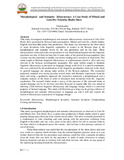Morphological and Semantic Idiosyncrasy: A Case Study of Mbusii and Lion De; Teketeke Radio Show
Abstract
This study investigated morphological and semantic idiosyncrasies witnessed in Teke-Teke
Radio Show presented by Kenyan radio personalities, Mbusii and Lion De, a Radio Jambo,
English cum Kiswahili prime time production. This study was informed by the observation
of acute deviations from linguistic regularities in respect to the Kenyan lingo at the
morphological and semantic levels by the two presenters and its fan base. These
idiosyncrasies witnessed in the two presenters it was noted had permeated into the linguistic
repertoire not only of their fan base but of some cadre of the general Kenyan populace, thus
in some way this repertoire it notably was slowly turning into a sociolect of some kind. This
study sought to illustrate linguistic idiosyncrasy as a phenomenon which is alive and very
relevant in the Kenyan sociolinguistic geography, this study further sought to illustrate
linguistic idiosyncrasy as precursor to language change at the level of a speech community,
this was evidenced by the proliferation of the linguistic peculiarities observed in the show
to general language use among some section of the Kenyan populace .The researcher
purposely sampled over twenty peculiar lexical items and idiomatic expressions from the
show and using a qualitative approach the researcher undertook a morphological and a
semantic analysis of the items in order to document their deviations from the linguistic
regularities. The research further made a survey of the presence of the aforesaid items in
regular language use by its fan base and other Kenyans in regular talk, this was aimed at
showing a link between linguistic idiosyncrasy and language change which is a universal
property of human language. This study will therefore go a long way in giving evidence of
morphological and semantic idiosyncrasies in language use and it will also cement the
notion of idiosyncrasy as precursor of language change.

